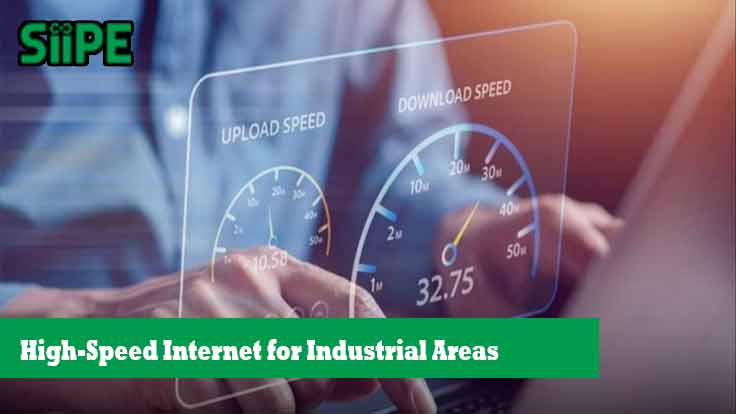In the fast-moving era of Industry 4.0 and soon 5.0, high-speed internet has become a critical infrastructure for industrial estates. It’s no longer just about staying connected—it’s about enabling smart factories, AI-driven logistics, and cloud-based automation that define modern industry.
If an industrial park doesn’t offer reliable and high-speed connectivity, it risks losing competitiveness, investors, and tenants. This article explains the importance, benefits, challenges, and real-world solutions of integrating high-speed internet in industrial areas.
Why High-Speed Internet is Crucial for Industrial Areas
Industrial zones today are far more complex than rows of warehouses and manufacturing plants. They are now digitally driven ecosystems that rely on uninterrupted data flows for everything—from monitoring machines to managing remote workers.
Here’s why it matters:
1. Factory Automation
Machines now run on software. Smart robotics, PLCs, and SCADA systems depend on real-time communication to function efficiently. Any latency can result in serious production delays or faults.
2. Smart Supply Chain
Internet of Things (IoT) and cloud-based logistics platforms allow for real-time tracking, stock alerts, and predictive inventory. Without fast internet, these systems simply don’t function optimally.
3. Surveillance & Compliance Monitoring
Smart industrial zones need IP surveillance, gas detectors, fire systems, and even emission monitoring. These systems send constant streams of data that require reliable bandwidth.
4. Real-Time Communication
From Zoom calls to SAP ERP systems, fast and reliable internet is essential for day-to-day decision-making, reporting, and coordination across departments or even countries.
Benefits of High-Speed Internet in Industrial Parks
The direct and indirect benefits of fast internet are significant:
✅ Increased Productivity
Processes run smoother, downtime is reduced, and machine data helps optimize output through real-time analytics.
✅ Better Safety & Risk Mitigation
With real-time video surveillance, leak detection, and emergency alert systems, safety becomes proactive—not reactive.
✅ Enhanced Investment Value
Tech-ready infrastructure is a key criterion for foreign direct investors and tech-based manufacturers.
✅ Seamless Remote Work
During pandemics or system downtime, remote access to factory dashboards, CCTV, and equipment is possible through secure, fast connections.
Common Challenges in Deployment
Despite the importance, many industrial areas struggle to implement high-speed internet because of:
⚠️ Remote Locations
Industrial parks are often located outside urban areas, making fiber optic rollout more difficult and expensive.
⚠️ Capital Expenditure
ISPs may be reluctant to invest unless they have guaranteed tenants, and developers often need to front the cost of infrastructure.
⚠️ Technical Skill Gaps
Some industrial parks lack in-house digital infrastructure teams, making implementation or troubleshooting harder.
⚠️ Coordination Between Stakeholders
Aligning developers, tenants, local governments, and ISPs requires strong management and long-term planning.
Solutions: How to Bring Fast Internet to Industrial Zones
Here are some practical strategies that have worked in developed and developing markets alike:
✅ Partner with ISPs at Planning Stage
Involve internet providers early when designing the estate. This helps ensure ducting, nodes, and towers are integrated before buildings are constructed.
✅ Hybrid Connectivity (Fiber + 5G)
Where fiber rollout is difficult, use 5G networks as a temporary or complementary option for high-bandwidth, low-latency needs.
✅ Edge Computing Gateways
Use local IoT edge nodes to process data on-site before uploading to the cloud—this reduces bandwidth pressure and increases speed.
✅ Establish a Private Industrial Network
Create a secure, dedicated network grid within the estate that interconnects all tenants and systems to a high-speed backhaul.
Case Studies from Around the Globe
Let’s look at some successful industrial zones with integrated digital infrastructure:
📍 Jurong Innovation District – Singapore
This tech-industrial zone features full 5G coverage, autonomous vehicles, and interconnected smart manufacturing labs.
📍 Amata Smart City Chonburi – Thailand
With 5G, cloud-based controls, and a digital twin model, this industrial park is an example of a public-private tech partnership.
📍 Batang Industrial Park – Indonesia (in progress)
Planned to be a future-ready estate with full fiber optic and cloud-connected infrastructure for advanced manufacturing.
📍 Düsseldorf Smart Factory – Germany
Factories here use gigabit internet, AI-powered predictive maintenance, and seamless cloud-to-machine interfaces.
Trends Shaping the Future
The future of industrial connectivity will go beyond just “speed.” These technologies will shape what’s next:
🔹 6G and Ultra Low Latency Networks
Expected by 2030, 6G will enable real-time AI processing, even more accurate remote robotics, and multi-site production orchestration.
🔹 Digital Twin Platforms
A real-time digital mirror of the physical factory allows for simulation, stress testing, and optimization—all relying on extremely fast internet.
🔹 AI-Driven Network Optimization
AI will automatically re-route bandwidth usage, prioritize mission-critical systems, and reduce latency during peak usage.
Q&A – Frequently Asked Questions
❓ What’s the minimum internet speed for an industrial zone?
Answer: A minimum of 100 Mbps symmetrical is common, but smart factories often need 1 Gbps or more, especially when handling high-definition video feeds and machine telemetry.
❓ Is fiber optic the only option for high-speed industrial internet?
Answer: Fiber offers the best performance and reliability. However, 5G and microwave links can be viable alternatives, especially for remote locations or temporary setups.
❓ Can multiple tenants share a single high-speed internet line?
Answer: Yes, but it must be managed with dedicated VLANs, QoS (Quality of Service), and monitoring tools to avoid congestion or data security issues.
❓ Who typically pays for internet infrastructure?
Answer: In most cases, the developer funds the backbone infrastructure, and tenants pay for their connections through selected ISPs.
❓ How does digital infrastructure impact ESG goals?
Answer: Smart monitoring reduces energy waste, enhances environmental compliance, and improves transparency—supporting the “E” in ESG.
High-speed internet isn’t just a tool—it’s the foundation for efficiency, safety, innovation, and sustainability in modern industrial areas. It supports everything from AI and automation to real-time monitoring and smart logistics.
Whether you’re a developer, policymaker, or factory owner—investing in digital infrastructure today will define your relevance tomorrow.











